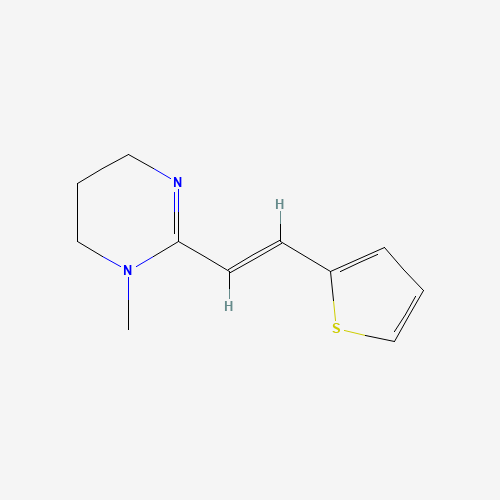| Pharmaceutical Information |
| Drug Name |
Pyrantel |
| Drug ID |
BADD_D01878 |
| Description |
Pyrantel is a pyrimidine-derivative anthelmintic agent for the oral treatment of various parasitic worm infections including ascariasis, hookworm infections, enterobiasis (pinworm infection), trichostrongyliasis, and trichinellosis [L1904].
Pyrantel was initially described in 1965 by researchers from Pfizer who sought cyclic amidines with suitable pharmacokinetic properties (specifically, duration of action) for use as an anthelmintic drug. Pyrantel is mainly available in formulations for dogs and cats as the embonate salt, containing a 34.7% pyrantel base [L1900].
Pyrantel is on the World Health Organization's List of Essential Medicines, which are the safest and most effective medicines required in a functioning health system [L1901], [L1902].
A depolarizing neuromuscular-blocking agent causing longstanding nicotinic receptor activation, resulting in spastic paralysis of susceptible nematodes (worms). Pyrantel has shown to be effective after a single dose [L1905].
In humans, it is administered as pyrantel pamoate [A32282],[A32283],[L1893],[L1898]. |
| Indications and Usage |
For the treatment of enterobiasis including roundworm (ascariasis), pinworm (enterobius) and hookworm (strongyloides) and hookworm (ancylostoma) in the pyrantel pamoate form [L1893].
Pyrantel is available in various formulations for humans, dogs, and cats as the pamoate (US Pharmacopeia nomenclature) or embonate (European Pharmacopoeia nomenclature) salt, which contains 34.7% pyrantel base combined with pamoic acid [L1893]. [L1900], [A32283].
Pyrantel pamoate (embonate) ingested orally is effective for removal and control of ascarid and hookworm infections in puppies and dogs (adult Toxocara canis, Toxascaris leonina, Ancylostoma tubaeforme, An. braziliense, Uncinaria stenocephala), cats (adult Toxocara cati, Toxa. leonina, An. caninum, An. braziliense, U. stenocephala), horses and ponies (adult and immature Parascaris equorum, adult Strongylus vulgaris, S. edentatus, S. equinus, Cyathostomes (Triodontophorus spp., Cyathostomum spp., Cylicodontophorus spp., Cylicocyclus spp., Cylicostephanus spp., Poteriostomum spp.), Oxyuris equi, Anoplocephala perfoliata), swine (adult Ascaris suum, Oesophagostomum dentatum), and humans (adult A. lumbricoides, Enterobius vermicularis, An. duodenale, Necator americanus) [L1900]. |
| Marketing Status |
approved; vet_approved |
| ATC Code |
P02CC01 |
| DrugBank ID |
DB11156
|
| KEGG ID |
D08451
|
| MeSH ID |
D011715
|
| PubChem ID |
708857
|
| TTD Drug ID |
D03PTH
|
| NDC Product Code |
Not Available |
| UNII |
4QIH0N49E7
|
| Synonyms |
Pyrantel |
|
| Chemical Information |
| Molecular Formula |
C11H14N2S |
| CAS Registry Number |
15686-83-6 |
| SMILES |
CN1CCCN=C1C=CC2=CC=CS2 |
| Chemical Structure |

|
|
| ADRs Induced by Drug |
|
|
*The priority for ADR severity classification is based on FAERS assessment, followed by the most severe level in CTCAE rating. If neither is available, it will be displayed as 'Not available'.
**The 'Not Available' level is hidden by default and can be restored by clicking on the legend twice..
|
|
|

